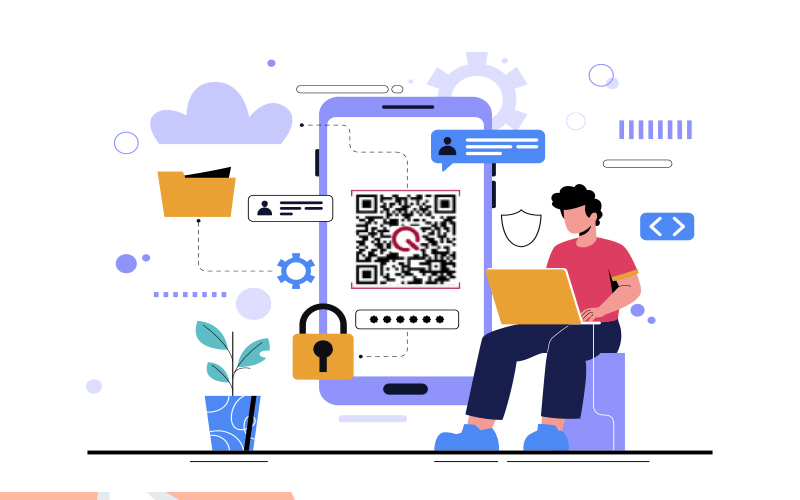
QR Code Accessibility Features for Inclusive Design
Making your business accessible to all is not only a moral imperative but also a strategic advantage. QR codes, with their simplicity and versatility, have the potential to revolutionize inclusivity by offering accessible experiences for people with disabilities.
This article delves into how QR codes can transform accessibility challenges into opportunities for inclusivity, empowering individuals and businesses alike.
Key Takeaways
- Enhancing Accessibility: QR codes provide quick access to essential information and services, aiding navigation and improving user experience.
- Limitations to Address: Reliance on visual scanning presents challenges for individuals with visual impairments, highlighting the need for alternative solutions.
- Practical Integration: Businesses can incorporate QR codes into their operations to make environments and services more inclusive.
The Inclusivity of QR Codes for People with Disabilities
Benefits of QR Codes
- Quick Access to Information:
- QR codes allow users to instantly access detailed information, including directions, product details, and multimedia content.
- Enhanced Navigation:
- In museums, sound maps linked to QR codes can guide visitors with visual impairments, improving their overall experience.
- Healthcare Applications:
- QR codes are effective in patient identification, reducing errors and enhancing the overall healthcare experience.
Limitations of QR Codes
- Visual Dependency: QR codes rely on scanning, making them less accessible to individuals with severe visual impairments.
- Limited Alternatives: Many QR code implementations lack tactile features or alternative access methods for those who cannot scan visually.
Digital Inclusion in the Future
As digital transformation accelerates, QR codes will play an increasingly important role in fostering inclusivity. Features like sound maps, interactive experiences, and accessible product labeling ensure that digital innovations cater to diverse needs. Collaborations with accessibility-focused organizations will be vital to improving QR code technology and making it universally inclusive.
How Businesses Can Use QR Codes for Accessibility
Getting a QR Code for Your Business
- Define Purpose: Identify the specific goal (e.g., accessibility, customer engagement, or navigation).
- Select a Generator: Choose a reliable QR code generator that offers customization for accessibility.
- Design for Inclusion: Incorporate high contrast, alt text, and alternative access methods.
- Test Thoroughly: Ensure the QR code works seamlessly across devices and environments.
- Deploy Strategically: Place QR codes in accessible locations, such as eye level or within reach of mobility devices.
Examples of Accessibility-Driven QR Code Use Cases
- Sound Maps for Navigation:
- QR codes can trigger audio-based navigation aids, guiding users through spaces such as museums or campuses.
- Accessible Museum Experiences:
- Scanning QR codes can provide multimedia content, offering descriptive audio tours and detailed exhibit information.
- Assistive Tools for Students with Hearing Disabilities:
- QR codes linked to video content, captions, or sign language tutorials can enrich learning experiences.
- Inclusive Packaging:
- Companies like Persil and Barilla have introduced QR codes on packaging to provide product details via voice descriptions for visually impaired users.
- Item Finder for Vision Impairments:
- Accessible QR codes can help users locate personal items or navigate storage spaces, enhancing independence.
Designing Inclusive QR Codes
Best Practices
- Provide Alternatives: Include URLs or NFC technology as supplementary options.
- Add Clear Instructions: Ensure users understand how to interact with the QR code.
- Ensure Accessibility Compliance: Use alt text and design elements compatible with assistive technologies.
- Optimize for All Devices: Test QR codes on various devices and under different lighting conditions.
The Impact of QR Code Usage on Different Disabilities
Positive Impacts
- Autism Spectrum: QR codes simplify instructions and provide structured information, reducing sensory overload.
- Low Vision: High-contrast designs and audio cues make QR codes more accessible.
- Dyslexia: QR codes can link to audio instructions or text-to-speech resources, aiding comprehension.
Challenges to Address
- Physical Disabilities: Ensure QR codes are reachable for individuals with limited mobility.
- Anxiety: Provide clear guidance to reduce pressure and frustration during interaction.
- Older Adults: Simplify instructions and design features to accommodate technological comfort levels.
WCAG Considerations for QR Codes
- Contrast and Clarity: Ensure that QR codes are visually distinguishable.
- Alternative Descriptions: Include alt text for screen readers.
- Accessible Placement: Position QR codes at accessible heights and locations for users with mobility devices.
Innovative Approaches to Accessible QR Codes
Enhanced “Accessible QR” Codes for Packaging
These codes combine traditional QR functionality with tactile features like dots and dashes, making them scannable for individuals with visual impairments.
The Power of the One Code Approach
A unified QR code design enhances usability by accommodating both standard and accessibility needs, bridging gaps in inclusivity.
Conclusion
QR codes hold immense potential to foster inclusivity and break down barriers for individuals with disabilities. By designing accessible QR codes, businesses can create equal opportunities for all, enhancing both user experience and brand reputation. With continued innovation and user feedback, QR codes will remain a vital tool in the journey toward a more inclusive digital future.